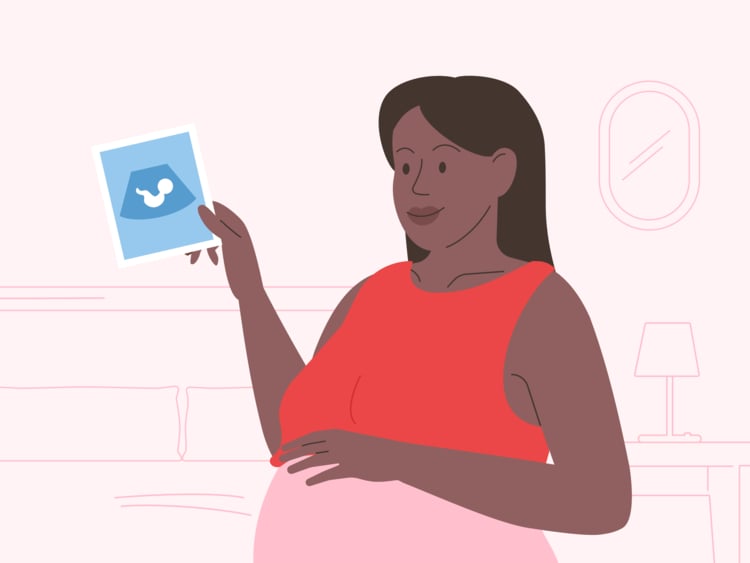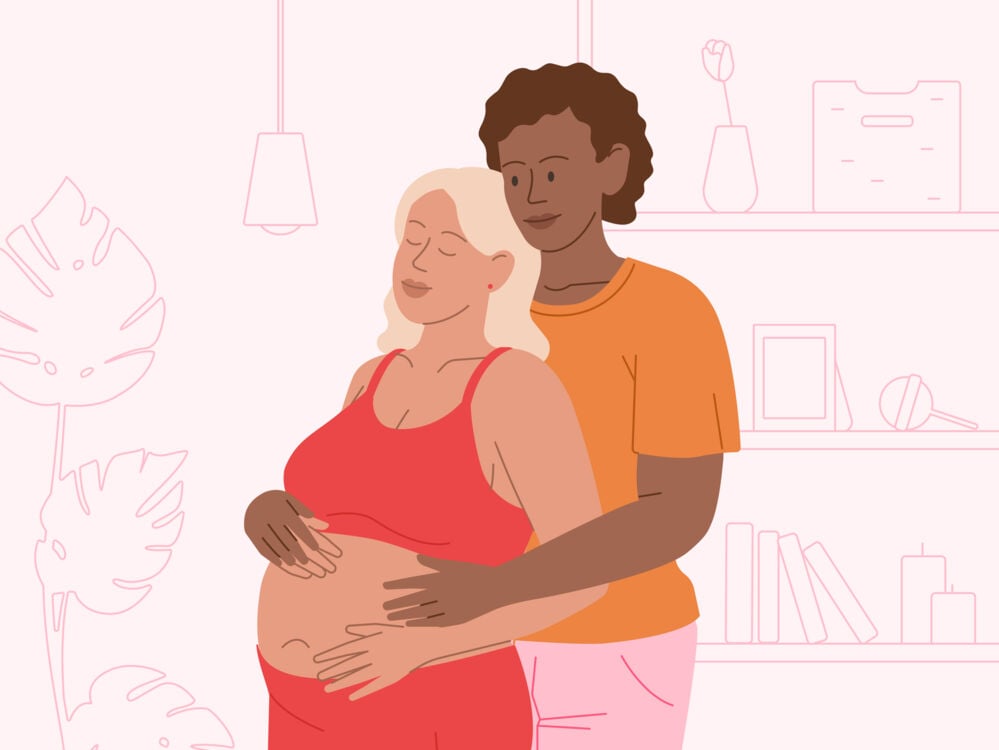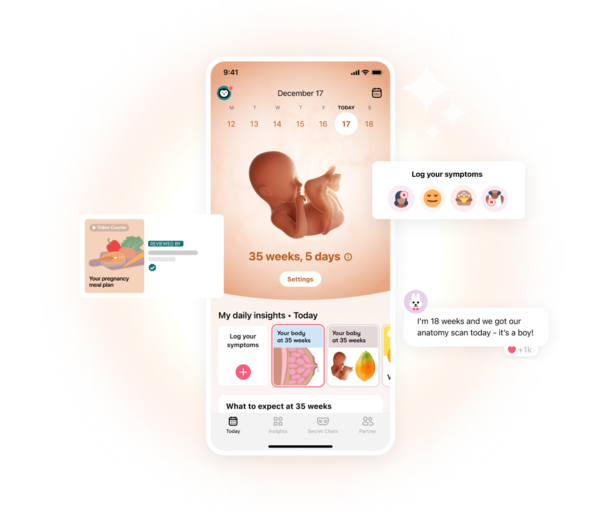You might be counting down the days until you feel your baby kick or flutter for the first time. But what other second-trimester pregnancy symptoms can you expect? And perhaps more importantly, why?
-
Tracking cycle
-
Getting pregnant
-
Pregnancy
-
Help Center
-
Flo for Partners
-
Anonymous Mode
-
Flo app reviews
-
Flo Premium New
-
Secret Chats New
-
Symptom Checker New
-
Your cycle
-
Health 360°
-
Getting pregnant
-
Pregnancy
-
Being a mom
-
LGBTQ+
-
Quizzes
-
Ovulation calculator
-
hCG calculator
-
Pregnancy test calculator
-
Menstrual cycle calculator
-
Period calculator
-
Implantation calculator
-
Pregnancy weeks to months calculator
-
Pregnancy due date calculator
-
IVF and FET due date calculator
-
Due date calculator by ultrasound
-
Medical Affairs
-
Science & Research
-
Pass It On Project New
-
Privacy Portal
-
Press Center
-
Flo Accuracy
-
Careers
-
Contact Us
Second-trimester pregnancy symptoms: What happens in the middle of pregnancy and why


Every piece of content at Flo Health adheres to the highest editorial standards for language, style, and medical accuracy. To learn what we do to deliver the best health and lifestyle insights to you, check out our content review principles.
You might have heard the second trimester of pregnancy referred to as “the sweet spot” — and there’s a good reason why. By now, you may have dealt with nausea throughout the day, those essential midafternoon naps, and changes to your taste and smell. You might even be able to see your bump poking out over your jeans. You’ve got that elusive glow.
However, pregnancy is still a huge thing for your body to go through, and all symptoms don’t necessarily disappear once you reach 14 weeks of pregnancy. At that point, you might start experiencing some of the symptoms commonly associated with your second trimester. So, what exactly can you expect?
It’s so important to remember that while it’d be really convenient if you could split your different pregnancy symptoms into three clear trimesters, it doesn’t always work like that.
“The trimesters are really broken down by how many weeks you are. There are some symptoms that can be more common in one trimester than the other, but there’s nothing that’s 100% in the first trimester or 100% in the second,” notes Dr. Charlsie Celestine, obstetrician and gynecologist, New Jersey, US.
So, what’s generally going on in your body during your second trimester, and why might it mean you start experiencing new symptoms?
Second-trimester pregnancy symptoms: What can you expect?
One of the easiest (and quickest) ways to know you’ve entered your second trimester is by keeping track of how many weeks pregnant you are. And just so you’re up to date, your first trimester wraps up at the end of 13 weeks.
Using a pregnancy app like Flo, you can easily count the weeks and monitor your body’s changes as you go. With Flo, you’ll get insights on what’s normal for your body, what to expect, and when to see a doctor.
At this point, many people report feeling much better and more “themselves” again. That’s because, often, some of the symptoms you experienced during your first trimester start to ease off.
“The second trimester is interesting because it’s usually the trimester where women feel the best,” explains Dr. Celestine. “During the first trimester, you [can feel] very sick. Your body is building a human being from scratch, which is what I like to tell my patients. So it can make you very tired and can drain you.”
Your second trimester can be quite different, but that’s not to say there isn’t a lot going on in your body then, too. During the first 13 weeks of pregnancy, your baby was growing and developing all of their organs. During the second trimester, they’ll be growing quickly and putting on weight. By around 20 weeks, you might be able to start to feel your baby moving around, which can be a really exciting milestone for any expectant parent.
Take a quiz
Find out what you can do with our Health Assistant
Common second-trimester pregnancy symptoms
You might be curious as to why you feel so different from your first to your second trimester. So let’s run through some of the most common second-trimester pregnancy symptoms and understand why they can happen.
First, though, you might be wondering whether your symptoms could hint as to whether you’re having a boy or a girl. It’s natural to look for clues if you don’t already know, right? One particular myth suggests that you might be able to guess the sex of your baby based on how you feel throughout your second trimester. So, is there any truth to it?
Some studies have suggested that women who experience a condition called hyperemesis gravidarum (severe nausea and vomiting during pregnancy) are more likely to have a girl than a boy. However, research into this is fairly limited. It’s safe to say that you shouldn’t settle on a baby name based on the symptoms you have during your second trimester. Sorry about that.
Your first trimester is a time of huge hormonal and physical changes, and your second trimester is no different. Continue reading to find out what your body might be about to experience and, most importantly, why.
A growing pregnant belly
Perhaps one of the most obvious signs that you’re progressing through your pregnancy and entering your second trimester is that your bump will start to show. Your bump grows because your baby is getting bigger and putting on weight, which is something to be celebrated! But remember, no two bumps are the same. Everyone develops at different paces, and this is totally normal.
During your second trimester, your uterus will grow and stretch to give your baby lots of space. To help your uterus stretch, your ovaries and placenta produce the hormone relaxin. As its name suggests, relaxin helps the two ligaments that surround your uterus (called round ligaments) and your pelvic muscles to loosen. As your bump grows, it stretches these ligaments, which can cause spasms and pain. This is called round ligament pain.
You might notice round ligament pain on one or both sides of your body. It might last for a few seconds, but some people can experience it for a few hours. And it might feel worse if you move suddenly (if you cough, sneeze, or laugh, for example).
Round ligament pain can be really frustrating, but if you’re experiencing it, an elastic belly band to support your baby bump might relieve the pain a little bit. Similarly, stretching might help.
Noticing cramping or pain around your bump can be really scary, and that’s very understandable. If you’re worried about how your bump is progressing or about any pain you’re experiencing, don’t be afraid to reach out to your health care provider. And if you notice the pain is accompanied by bleeding or tightening that feels like what you might imagine contractions feel like, then definitely call your doctor.
And remember: There’s no such thing as the perfect bump. It can be so hard not to compare yourself to other pregnant people around you, but you and your baby will grow in your own time.
Itchy skin
Along with getting bigger, your bump might also become itchy. This may seem like a strange development, but it happens as the skin on your tummy stretches over time.
Itchiness on your body is also pretty common during pregnancy due to the fact that your estrogen, progesterone, and prolactin hormones increase. However, if you find a rash on your bump or the itching is driving you to distraction, reach out to your doctor.
Feeling your baby’s movements
Perhaps one of the most rewarding developments is that anywhere between 16 and 24 weeks, you’ll start to feel your baby moving. This is because they’ve grown big enough to feel them inside.
At first, their movements might feel like butterflies in your tummy or bubbles. As they continue to grow, you might feel more pronounced kicks and elbows. And just like your bump growth, everyone is different, which means you may feel these movements slightly earlier or later than others. That’s to be expected, but if you’re worried about your baby’s movements or the lack of them, then chat with your health care provider.
Aches and pains
Annoyingly, round ligament pain might not be the only ache you can expect during your second trimester. You might also notice vaginal pain and what’s called pelvic girdle pain. This affects around one in five women and can be felt anywhere in the pubic area, hips, groin, lower back, knees, or thighs. It’s caused by the extra weight from your baby and the changes to your posture during pregnancy, which makes sense when you think you’re constantly carrying another human around!
Heartburn
We said your second trimester might feel a little bit better than your first. And that’s true, but it can come with its challenges, too. One symptom that you might find particularly tricky is heartburn, as it can occasionally prevent you from enjoying some of your favorite treats.
Between 17% and 45% of pregnant people experience heartburn at some point, and it’s another symptom that you can blame on your changes in hormones. Your progesterone levels rise at the beginning of pregnancy and remain high throughout your second trimester. This relaxes your digestive system and slows down how quickly you process food, which can cause heartburn and constipation.
Not exactly pleasant, but you can try to help ease any discomfort by eating more healthily, having smaller meals, and trying to sit upright when you eat.
If your heartburn isn’t getting any better after taking over-the-counter medication, or you notice that it’s combined with abdominal pain — especially on your right side — then you should reach out to your health care provider. This could be an early sign of a pregnancy complication called preeclampsia.
Increased appetite
There’s no big secret behind why you might have a bigger appetite during your second trimester. You’re making a growing baby, and as they get bigger, they’ll need more nourishment from you. If you find you’re hungrier than usual, embrace it!
You’ll need approximately 340 extra calories per day during the second trimester. Sadly, it’s not advised that you get these extra calories in the form of your favorite donut or cake. Fill up on nutritious foods that will set you and your baby up to thrive.
Change in skin pigmentation
Your bump growing isn’t the only visible change you might notice during your second trimester. The skin around your face may have gotten darker. This is called chloasma or melasma and is experienced by around 50% to 70% of people who are pregnant. It may last for the duration of your pregnancy before disappearing by itself.
Another common change to your skin during the second trimester is the linea nigra. This is a dark line that can form from your upper tummy area (under your boobs) down to your pubic area. It’s most common to spot this line on your lower tummy area.
Experts aren’t really sure what causes the linea nigra, and not everyone will develop one. However, some have said that it could be due to the fact that your placenta creates a hormone called melanocyte-stimulating hormone, which can increase your melanin levels during pregnancy (melanin gives skin its pigment).

Unexpected pregnancy symptoms in the second trimester
By the time you’re 14 weeks pregnant and beyond, you’re probably well aware of the fact that some parts of pregnancy can be a little bit strange and unexpected. It isn’t all glamorous baby bump photoshoots and mocktails with your friends.
And just like during your first trimester, there may be some second-trimester pregnancy symptoms that you didn’t see coming.
Nosebleeds
You wouldn’t be blamed for thinking that nosebleeds are a strange pregnancy symptom — but they’re actually pretty common. One study suggests that 20.3% of pregnant women will experience nosebleeds. However, they should only last between a few seconds and no longer than 10 minutes. If they last any longer than that, then you should reach out to your health care provider.
If you experienced a stuffy nose and congestion throughout your first trimester, then you might be interested to know that this is all linked. During your first trimester, the amount of blood that flows around your body increases by between 20% and 100%. This can cause the blood vessels in your nose to swell, and the increased pressure can cause them to burst. This means you’re at a greater risk of having a nosebleed. Don’t forget to carry a packet of tissues everywhere you go!
Bleeding gums
While we’re on the topic of bleeding, let’s talk gums. Bleeding gums, otherwise known as pregnancy gingivitis, is another symptom you might want to make note of. It’s thought to affect as many as 80% of pregnant people.
And the reason for this is? You guessed it: your hormones — namely a rise in estrogen and progesterone. Your hormones increase blood flow to the mucous membranes in your gums, which can leave them feeling swollen, sore, and more likely to bleed.
All of this makes it even more important to look after your teeth and gums during pregnancy and let your doctor and dentist know if you’re experiencing this. At the risk of sounding like your dentist, you can pay extra care and attention to your teeth and gums by making sure you brush twice a day, keeping up with flossing, and avoiding too much sugar.
Vaginal discharge
Your body changes a lot throughout your second trimester, but one thing you may not have expected is that you’ll produce more vaginal discharge. Typically, discharge is white or translucent; wet, sticky, or creamy; and doesn’t have a strong smell. You can learn all about how your discharge might change using an app like Flo.
During pregnancy, you produce more vaginal discharge than normal to protect you from infections. You might also notice that it’s stickier or stringier than usual. If you see it in your underwear, there’s no need to worry. It’s just your body doing its best to protect you. However, if you’re worried about the color, smell, amount, or consistency of your discharge, then reach out to your health care provider.

When do second-trimester pregnancy symptoms stop?
Pregnancy symptoms are hard to predict. They’re so varied and can be different from person to person and even pregnancy to pregnancy. Annoyingly, it’s impossible to guess when they’ll stop.
However, as you enter your third trimester (from 28 weeks pregnant onward), you may notice some of your second-trimester symptoms calming down. In their place might be new symptoms as your body prepares itself for birth. .
When should you seek medical help?
Hopefully, you now feel a lot more prepared for what to expect during the middle of your pregnancy, with an added understanding of why it all might happen.
You might also find it useful to follow a weekly checklist, like the one in the Flo app, to help you prepare for your baby’s arrival. Meanwhile, you can use Flo’s secret chats to share your experiences and get support from a community of other parents-to-be.
But it’s crucial to remember that if you’re ever in doubt about something that doesn’t feel right, always contact a health care professional. It’s better to seek medical advice instead of worrying at home.
Two key things you should always reach out to a doctor immediately about during pregnancy are bleeding from your vagina and severe pain. “If you’re doubled over in pain, or if the pain is stopping you from doing activities, then it’s severe,” says Dr. Celestine. “Or if you have vaginal bleeding [that’s] like a period flow, we’d need to check that out.”
These signs might sound really scary, but remember that your health care provider will do their best to support you and your baby. They’ll know what to do next and be able to explain what’s going on to you.
Second-trimester pregnancy symptoms: The takeaway
The journey to giving birth is far from a straight and easy road, but it is certainly filled with some exciting moments. You’ll feel your baby move for the first time during your second trimester, and your bump will start to grow.
However, not all second-trimester pregnancy symptoms are quite as enjoyable. You might not feel nauseous anymore but could be contending with bleeding gums, an itchy belly, or heartburn. Every stage of pregnancy is characterized by new signs, and soon your body will be preparing to welcome your baby into the world.
With Flo, you can easily log and follow your symptoms throughout your pregnancy. Week-by-week, you’ll find insights, courses, and articles created with health experts to help you make sense of the latest guidance and your body’s changes.
It’s important to remember that symptoms don’t work on a strict timeline. You might not experience any or all of the things mentioned above, or perhaps your first-trimester pregnancy symptoms may still be lingering. That could be perfectly normal, but if you ever feel unsure or worried about what you’re going through, then speak to your health care provider. They’ll be ready to check you over and support you as you continue on your pregnancy journey.


Hey, I'm Anique
I started using Flo app to track my period and ovulation because we wanted to have a baby.


The Flo app helped me learn about my body and spot ovulation signs during our conception journey.


I vividly
remember the day
that we switched
Flo into
Pregnancy Mode — it was
such a special
moment.
Real stories, real results
Learn how the Flo app became an amazing cheerleader for us on our conception journey.
References
“1st Trimester Pregnancy: What to Expect.” Mayo Clinic, 8 Mar. 2022, www.mayoclinic.org/healthy-lifestyle/pregnancy-week-by-week/in-depth/pregnancy/art-20047208.
“2nd Trimester Pregnancy: What to Expect.” Mayo Clinic, 9 Mar. 2022, www.mayoclinic.org/healthy-lifestyle/pregnancy-week-by-week/in-depth/pregnancy/art-20047732 .
“2nd Trimester Pregnancy: What to Expect, Development & Tests.” Cleveland Clinic, https://my.clevelandclinic.org/health/articles/16092-pregnancy-second-trimester. Accessed 1 Dec. 2022.
“Bleeding Gums in Pregnancy.” NHS, www.nhs.uk/pregnancy/related-conditions/common-symptoms/bleeding-gums/. Accessed 5 Dec. 2022.
Bolanca, Ivan, et al. “Chloasma: The Mask of Pregnancy.” Collegium Antropologicum, vol. 32 suppl. 2, Oct. 2008, pp. 139–41.
“Indigestion and Heartburn in Pregnancy.” NHS, www.nhs.uk/pregnancy/related-conditions/common-symptoms/indigestion-and-heartburn/. Accessed 5 Dec. 2022.
“Linea Nigra.” Cleveland Clinic, https://my.clevelandclinic.org/health/body/23488-linea-nigra. Accessed 1 Dec. 2022.
“Melasma (Chloasma).” Harvard Health, 1 Apr. 2019, www.health.harvard.edu/a_to_z/melasma-chloasma-a-to-z.
“Nosebleeds While Pregnant.” Cleveland Clinic, https://my.clevelandclinic.org/health/symptoms/22342-nosebleeds-while-pregnant. Accessed 1 Dec. 2022.
“Nutrition during Pregnancy.” The American College of Obstetricians and Gynecologists, www.acog.org/womens-health/faqs/nutrition-during-pregnancy. Accessed 5 Dec. 2022.
“Pelvic Girdle Pain and Pregnancy.” Royal College of Obstetricians and Gynaecologists, www.rcog.org.uk/for-the-public/browse-all-patient-information-leaflets/pelvic-girdle-pain-and-pregnancy/. Accessed 1 Dec. 2022.
Piccioni, Maria Grazia, et al. “Management of Severe Epistaxis during Pregnancy: A Case Report and Review of the Literature.” Case Reports in Obstetrics and Gynecology, vol. 2019, Jan. 2019.
“Pregnancy Gingivitis.” Cleveland Clinic, https://my.clevelandclinic.org/health/diseases/22484-pregnancy-gingivitis. Accessed 1 Dec. 2022.
“Pregnancy: How Your Digestion Changes.” University of Rochester Medical Center, www.urmc.rochester.edu/encyclopedia/content.aspx?contenttypeid=90&contentid=P09521. Accessed 1 Dec. 2022.
“Quickening In Pregnancy: First Movements & What to Expect.” Cleveland Clinic, https://my.clevelandclinic.org/health/symptoms/22829-quickening-in-pregnancy. Accessed 1 Dec. 2022.
Rashid, M., et al. “Hyperemesis Gravidarum and Fetal Gender: A Retrospective Study.” Journal of Obstetrics and Gynaecology, vol. 32, no. 5, July 2012, pp. 475–78.
“Relaxin.” Your Hormones, www.yourhormones.info/hormones/relaxin/. Accessed 1 Dec. 2022.
“Round Ligament Pain.” Cleveland Clinic, https://my.clevelandclinic.org/health/symptoms/21642-round-ligament-pain. Accessed 1 Dec. 2022.
Sanghavi, Monika, and John D. Rutherford. “Cardiovascular Physiology of Pregnancy.” Circulation, vol. 130, no. 12, Sep. 2014, pp. 1003–08.
“The Second Trimester.” Johns Hopkins Medicine, 8 Aug. 2021, www.hopkinsmedicine.org/health/wellness-and-prevention/the-second-trimester.
Vazquez, Juan C. “Heartburn in Pregnancy.” BMJ Clinical Evidence, vol. 2015, Sep. 2015, www.ncbi.nlm.nih.gov/pubmed/26348641.
“Vaginal Discharge in Pregnancy.” NHS, www.nhs.uk/pregnancy/related-conditions/common-symptoms/vaginal-discharge/. Accessed 1 Dec. 2022.
“Your Baby’s Movements.” NHS, www.nhs.uk/pregnancy/keeping-well/your-babys-movements/. Accessed 1 Dec. 2022.
“Week-by-Week Guide to Pregnancy” Better Health: Start for Life, www.nhs.uk/start4life/pregnancy/week-by-week/2nd-trimester/week-13/. Accessed 1 Dec. 2022.
Wu, Min, et al. “Relationship between Gingival Inflammation and Pregnancy.” Mediators of Inflammation, vol. 2015, Mar. 2015.
History of updates
Current version (19 June 2023)
Published (25 February 2019)
In this article

Get your personal guide to pregnancy with the Flo app
-
Follow your baby's growth week by week
-
Get expert info on symptoms, safe foods, and more
-
Chat with other parents-to-be




